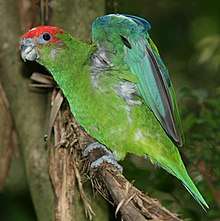Pileated parrot
The South American pileated parrot (Pionopsitta pileata), also known as the red-capped parrot (leading to easy confusion with the Australian Purpureicephalus spurius), is a medium-small species of parrot with a total length of about 22 cm (8.7 in). It is found in or near the Atlantic Forest in south-eastern Brazil, far north-eastern Argentina and eastern Paraguay. A local name in Paraguayan Guaraní is cúiu cúiu.
| Pileated parrot | |
|---|---|
 | |
| male | |
| Scientific classification | |
| Kingdom: | Animalia |
| Phylum: | Chordata |
| Class: | Aves |
| Order: | Psittaciformes |
| Family: | Psittacidae |
| Genus: | Pionopsitta Bonaparte, 1854 |
| Species: | P. pileata |
| Binomial name | |
| Pionopsitta pileata (Scopoli, 1769) | |
Unlike all other species previously placed in the genus Pionopsitta, the pileated parrot does not have a contrasting brownish-olive chest, and recently it was established via mtDNA that it is indeed distinct enough for the others to be moved into a separate genus, Pyrilia, again making Pionopsitta monotypic.
Description
The plumage of the pileated parrot is overall green with bluish flight feathers, a faint brownish-maroon auricular patch (lacking in juveniles) and, in the male, a bright red forehead that extends down to just below the eyes.
References
- BirdLife International (2012). "Pionopsitta pileata". IUCN Red List of Threatened Species. 2012. Retrieved 26 November 2013.CS1 maint: ref=harv (link)
- Ribas, C., R. Gaban-Lima, C. Miyaki, and J. Cracraft (2005). Historical biogeography and diversification within the Neotropical parrot genus Pionopsitta (Aves: Psittacidae). Journal Biogeography 32:1409-1427.
